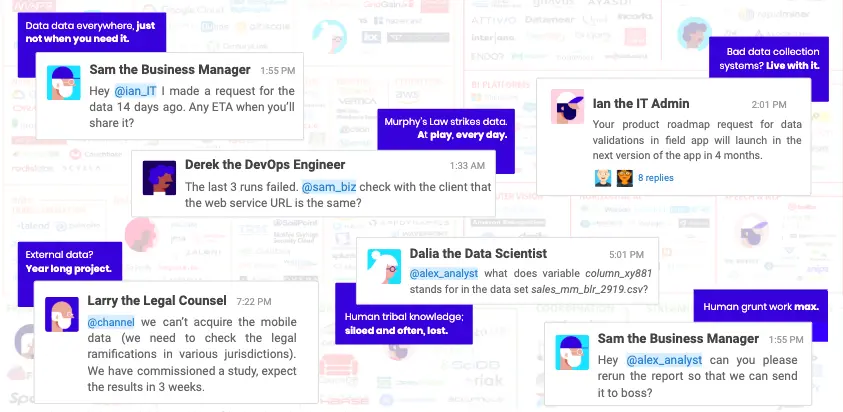Data Management 101: Four Things Every Human of Data Should Know

Share this article
First, if you’re a human of data – aka someone who works with data for a living – here’s your virtual medal. 🏅🏅🏅
Why? Because we know how frustrating it can be to manage data and all its appendages, from metadata to data lineage and beyond! Now we know we can’t wave a magic wand and wish it all away 🔮 .
But, in the meantime, we can make it easier for you to navigate the data verse. That’s why we’ve created this super simple guide to help you understand the basics of data management and more importantly, understand the best approach to managing your data.
Without any further ado, here’s data management 101: four things you should know.
#1 What is data management?
Permalink to “#1 What is data management?”If you’ve ever Googled this term, you would have realized—the more you Google, the less you know. That’s because data management is a very vast field with ever-changing definitions and scope. Just like urban slang or dance moves (dab, anyone?).
But, we can all safely agree that at its basic, data management is the management of data throughout its lifecycle in an organization—from data ingestion and discovery to data analysis and governance.
Need the experts to weigh in? Well, here you go.
Data management (DM) consists of the practices, architectural techniques, and tools for achieving consistent access to and delivery of data across the spectrum of data subject areas and data structure types in the enterprise, to meet the data consumption requirements of all applications and business processes. - Gartner Glossary
Incidentally, data management shows up as one of 9 trending terms on the Gartner Glossary. 😎 Now that you’ve understood the basics, let’s dive into the depths.
#2 How does data management help you?
Permalink to “#2 How does data management help you?”A solid data management strategy and platform will help you manage data at every step and for every use case by giving you the following capabilities:
Data integration: Struggling to ingest data from diverse sources, formats and types? Or still need to loop in your data and infrastructure engineers every time you need to ingest petabytes of data? Data management can help you do all this without breaking a sweat.
Data catalog: Still find it a nightmare to discover, share and collaborate on your data assets? By setting and following healthy data management practices, you can boost the discovery and visibility of the data that you already have.
Wondering how data catalogs can help your team boost data discovery and access? Read this article for all the answers you need.
Data analytics: Do business users in your company frequently complain about how it takes them forever to get the data they need or get the insights they requested? All this can be a thing of the past with modern data management practices.
Data governance: Is it really possible to collaborate on data while ensuring its security and integrity? Yesss! Solid data management practices can help you work with data AND stay on the right side of the laws of the land.
Looks all hunky-dory then, right? Nope! Here’s the twist in the story…
#3 What are the biggest challenges in data management?
Permalink to “#3 What are the biggest challenges in data management?”Data has become the new oil, the new currency, the new moat and what not.
This means that business is now realizing the tremendous value of data and making data-driven decisions. So naturally, data and analytics leaders have to manage and accommodate diverse business requirements—from data scientists building complex models to business users running simple SQL queries.
But at the same time, they have to manage data governance and compliance enterprise-wide. That’s a daunting task for any CDO or analytics leader.

Challenges faced by the humans of data - Image by Atlan.
The two biggest challenges in data management are centered around data catalogs—finding and identifying data that delivers value, and supporting data governance and data security. - Gartner Data Management Strategy Survey 2017
Given the diversity of use cases that could present themselves, it’s clear that there’s no point setting up your data and metadata management to suit only one use case. You need to adopt a data management strategy that lets you cater to an infinite number of possibilities of what data can do for you and your team.
The bottom line?
Changing requirements from both business and IT are driving demand for data quality tools, data catalogs, metadata management solutions and data integration tools in one comprehensive solution, according to Gartner.
#4 What does the writing on the wall say when it comes to data management?
Permalink to “#4 What does the writing on the wall say when it comes to data management?”The message is loud and clear. 📢
Instead of adopting data management tools that solve only specific use cases, companies must adopt a data management platform that integrates data discovery, access, analytics and governance in one place. This will help them create a modern data management infrastructure that goes beyond the siloed approach of traditional data management tools.
To succeed with data and analytics initiatives, enterprises must develop a holistic view of critical data management capabilities… Demand for data management capabilities has translated into demand for convergence of capabilities across data management tools and solutions. - Gartner research
And that’s it! Now go forth and manage your data like a pro!
Share this article






















